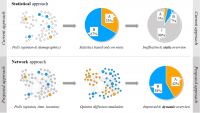Research Projects
IMPRESS: IMproving the PREdiction of opinion dynamics in temporal Social networks: mathematical modeling and Simulation framework
In a rapidly evolving world, with growing population and accelerated access to online media, the need to understand the structures and behavior of human society has become more important than ever. Having emerged as an interdisciplinary field in the 21st century, social networks analysis is on the quest to understand opinion formation and diffusion from a scientific point of view. The formation of social networks, namely the way connections are created and strengthened, is a very complex process, and there are many factors that interfere for the emergence and evolution of social ties. Notable research efforts try to explain the high complexity of such network structures, by proposing corresponding algorithmic models. Nevertheless, available models have many limitations as they typically assume opinion interaction mechanisms based on fixed thresholds, static topologies, or omnipresent opinion sources.
This project comes to improve our understanding of opinion diffusion in emergent social networks. Consequently, to build models that are aware of these phenomena, I propose fundamental topological analysis of empirical data - using network motifs, community detection algorithms and statistics - to understand the behavioral patterns and centralities which have an impact on spatial and temporal distribution of opinion. As opposed to most existing opinion interaction models, I propose a temporal opinion injection model which evolves over time according to basic human traits and underlying social topology. Also, by employing discrete event simulation on real-time gathered social network data, I propose the implementation of an online platform to offer improved prediction on poll outcomes for socially-relevant topics.
In the wake of big data analytics, this project sets out to push the boundaries of scientific understanding of opinion dynamics in social networks by analyzing how the underlying network topology influences communication patterns and polarization of opinion.



